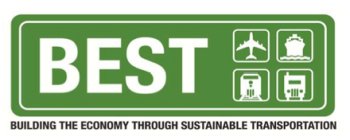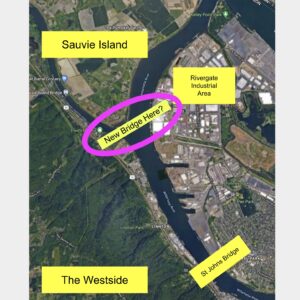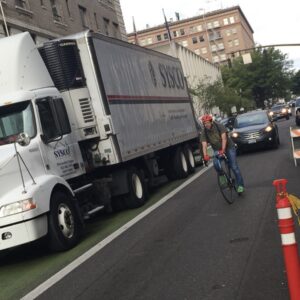“A disproportionate share of… dollars available for transportation projects… are being allocated to… bicycle, pedestrian, and commuter infrastructure while critical freight-related projects go unfunded.”
— From a BEST coalition document
As I detailed on Wednesday, active transportation advocates are mobilizing to thwart an attempt by freight and business advocates to get a larger piece of an important infrastructure funding source.
This freight activism has raised eyebrows because it’s coming from what I’ve recently learned is the state’s first privately-funded, professionally represented coalition whose sole purpose is to make the case for freight infrastructure and to remedy what they see as a “disproportionate share of funding” going to biking and walking projects.
Here’s a reset of the issue…
Metro needs to allocate about $20 million in federal “regional flexible funds” and the committee that doles them out, the 17 Joint Policy Advisory Committee on Transportation (JPACT) — which consists of local elected officials (including Mayor Sam Adams), citizen advocates, and three Metro Councilors — will vote next week (July 8) on a set of parameters on how to divide up the cash. In the last two funding cycles, active transportation has won big, garnering $39.8 million out of $44.9 million allocated. Meanwhile, just $3.7 million has gone to freight projects.
Active transportation advocates want to maintain these historical funding levels, but freight advocates say their projects aren’t getting a fair share. A coalition called BEST, which stands for Building the Economy through Sustainable Transportation sent a letter to JPACT proposing a 75/25 freight/active transportation funding split.
I’ve came across a document outlining BEST’s mission, their “business case” for freight projects, their objectives, and how they are funded (PDF here).
The PR firm behind BEST is Hubbell Communications based in Southeast Portland and headed by Ward Hubbell.
Here’s their mission statement:
“Facilitating economic growth, highway safety and reduced environmental impacts by ensuring an adequate infrastructure for the efficient movement of freight in the Portland Metro region.”
Why do they feel there’s a need for a new freight coalition? Here’s an excerpt from their “Business case”:
“A disproportionate share of local, state and federal dollars available for transportation infrastructure projects in the Portland metropolitan area are being allocated to projects supporting bicycle, pedestrian and commuter infrastructure while critical freight-related projects go unfunded.”
BEST has already succeeded in positioning their projects as being “green.” The official category description of their projects being used by Metro is “Green Economy/Freight Initiatives” and the group’s literature is full of phrases touting freight projects that will “advance a green economy,” provide a “more sustainable transportation infrastructure” and “reduced environmental impacts.”

The principle reasons behind BEST’s claim of being “green” is that investment in freight projects will reduce trip time, would allow them to deliver “green economy” products more efficiently, and would reduce the environmental footprint of the supply chain. One of the things BEST will focus on to achieve these “green” objectives is “development of large projects to relieve freight bottlenecks.”
“Groups that advocate for active transportation will likely be mobilizing their own stakeholders to impact this funding decision and we need the freight community to do the same.”
— From an email sent to freight stakeholders by a consultant working for the BEST coalition
Read a more complete outline of BEST’s definition of a “green economy” here (PDF).
To be a voting member of the BEST coalition, there are four tiers of membership with dues based on the size of the company. Large companies (annual revenue greater than $1 billion) can join at $7,500 to $10,000 a year, medium sized companies (revenue between $500 million and $1 billion) can get a vote for $5,000 per year and small companies (revenue less than $500 million) can join for $2,500 a year. Trade associations can get a vote for $5,000 per year.
For a new advocacy group, BEST has started out with a bang. A consultant with the PR firm hired to manage the campaign wrote in an email to freight stakeholders on June 10th that their letter to JPACT “was very well-received by both Metro and JPACT members.”
That email also included an appeal to match the efforts of active transportation advocates:
“This is our opportunity to impact an important funding allocation decision at the regional level and I urge you all to help BEST push for increased funding for freight infrastructure improvements. Groups that advocate for active transportation will likely be mobilizing their own stakeholders to impact this funding decision and we need the freight community to do the same.”
Active transportation advocates have reason to care about this new coalition. From the professional PR firm that’s creating its messages to its backing by many powerful regional corporations and pro-business interests*. Its emergence also comes at a time when the economy and job growth are extremely politically viable.
It’s also important to note that active transportation advocates lack a true counterpart to this group. Metro has an internal Active Transportation Partnership which has been very effective in ramping up lobbying and project readiness efforts. But, given that they’re an official Metro entity, they’ve got to carefully balance their involvement. There’s also a host of other non-profits advocating for active transportation (the BTA being out in front the most), but they are a diverse group that has no single, unifying voice — and they certainly cannot match the PR and public policy messaging experience of Hubbell Communications.
JPACT will vote on how to split up the flexible fund allocation at their meeting on July 8th.
*Here is the list of signatories on a letter from BEST to JPACT dated June 8th:
- Bill Wyatt, Executive Director, Port of Portland
- Bernie Bottomly, Vice President, Government Relations & Economic Development, Portland Business Alliance
- Bob Russell, President, Oregon Trucking Associations
- Mike Salsgiver, Executive Director, Associated General Contractors – Oregon-Columbia Chapter
- Deanna Palm, President, Hillsboro Chamber of Commerce
- Trey Chanter, South Metro Business Alliance
- John Mohlis, Executive Secretary Treasurer, Columbia Pacific Building Trades Council
- Jeff Stone, Director of Government Relations, Oregon Association of Nurseries
- Martyn L. Shaddix, Director of US Distribution, Columbia Sportswear USA Corp.
- Joshua L. Collins, Chief Executive Officer, Blount International
- Greg Miller, Oregon Public Affairs Manager, Weyerhaeuser
- Melinda Merrill, Director of Public Affairs, Fred Meyer Stores
- Tom Zelenka, Public Affairs Manager, Schnitzer Steel
- Brett Hinsley, Business Manager, Cement Masons Local 555
- Linda Pearce, Executive Vice President & CFO, Warn Industries
- Tom Deschenne, Associate Vice President, Norris, Beggs & Simpson
- Susan Wilson, Director of Public Affairs, The Greenbrier Companies







Thanks for reading.
BikePortland has served this community with independent community journalism since 2005. We rely on subscriptions from readers like you to survive. Your financial support is vital in keeping this valuable resource alive and well.
Please subscribe today to strengthen and expand our work.
I support the BEST agenda because it will actually have a positive impact on the environment and livability, as opposed to the feel-good, but wasteful and counterproductive light rail agenda.
Options should reflect the communities needs and not those of businesses’ claiming to work for the citizens (i.e. – in the guise of ‘non-profitism’) instead of their shareholders and/or bottom line; usually the REAL issue.
Funding for bike/ped projects are only 1% of Oregon roadway funding…
Are the facts of misapropriation too overwhelming for basic rights logic?
Less roads = less traffic, (studies have been done)…the agents at BEST are trying to have OUR cake AND eat it too.
The real question – is this just about getting a bit more funding for freight or is this about corporate interests creating a wedge issue between groups that are (mostly) political allies (unions, environmentalists, active transportation advocates, community health advocates)?
Have they posted their position on the Columbia River Crossing?
You can’t spell BEST without BS.
“One of the things BEST will focus on to achieve these “green” objectives is “development of large projects to relieve freight bottlenecks.”
Hmmm..now what could that possibly mean????
“… One of the things BEST will focus on to achieve these “green” objectives is “development of large projects to relieve freight bottlenecks.” maus/bikeportland
Freight delivery does face growing problems making deliveries as highways become increasingly congested. A couple years ago, the O did a good story on these problems.
What’s BEST referring to as ‘freight bottlenecks’? First thing that comes to mind is the commuter traffic jams on I-5. Is this what BEST has in mind? If the “…large projects…” BEST refers to are bigger interchanges and so forth, I’m not convinced that they’re going to help reduce freight bottlenecks.
A reduction in the number of single occupancy commuter motor vehicles is probably the key element that would most help to reduce freight bottlenecks. What’s BEST’s best idea for accomplishing such a reduction?
Greg…I know it’s expensive, but sorry, I don’t agree that light rail is either wasteful or counterproductive in terms of addressing the metro areas’ transportation problems. Almost anything to attract people away from the single car travel obsession is probably worth it. Without such transportation options, would we be eventually obliged to double, triple the width(how wide?) of, for example…Hwy 26 between Portland and Hillsboro?
In fact, a it seems that a really smart idea for BEST, would be for it to request a larger share of the pot for the purpose of expanding interurban freight rail capacity. Let it help the freight business become less dependent on ‘freeways’ to move the goods.
wsbob has it right – “A reduction in the number of single occupancy commuter motor vehicles is probably the key element that would most help to reduce freight bottlenecks.”
There has been cooperation between bike/ped advocates and freight interests before, on this common ground that reducing SOV trips is better for everyone. Jonathan, any idea why that relationship dissolved? Of course, it might be hard to revive for a while as “BEST” takes this antagonistic stance by attempting to unfairly appropriate the “green” reputation of bicycle and pedestrian interests. I see this story and wonder why freight and active transportation can’t be friends.
I’m not usually one to harp about the CRC, but this is a case where the region’s largest proposed transportation project of the decade is being pushed for, in part if not primarily, for the benefit of freight movement. That’s $4,000+ million on the table for freight, and they’re trying to scare active transportation advocates away from picking up some $20 million crumbs.
More like “BUST” – Building UnSustainable Transportation. None of the icons on their logo is a sustainable mode.
This is encouraging, since we’re now at Ghandhi’s 3rd stage of the fight. (“First they laugh at you, then they ignore you, then they fight you, then you win”)
Elliot,
Just because this coalition exists doesn’t mean there aren’t still solid relationships between some active transportation and freight advocates.
Thanks Jonathan #10. Can you explain any more about if/how this is stressing the relationship, or if BEST is just a section of the freight industry that hasn’t worked with active transportation before? BEST’s proposal seems pretty much a like shot across the bow of active transportation’s Metro funding ship, and I’m just trying to parse how this came about when the two groups seemed somewhat connected before.
It was my impression that in the past, each group would bring a list of their desired projects to the table to be evaluated on individual merit… whereas this development seems to indicate a sort of meta-negotiation, where a percentage split is worked out before individual projects are presented. It seems more guttural – like freight and active transportation are in direct competition when it wasn’t framed that way previously.
Elliot,
i can only think this stresses the relationship because you have a paid consultant/communications firm supported by corporations who are essentially saying, “we think you’re getting more money than you should, so we’re going to try and stop that and get more money for ourselves.” also, given that this group is advocating for projects that reasonable people would have trouble seeing a “green” benefit to, i don’t think that starts things off on a great foot.
and your 2nd para. touches on a very relevant issue being discussed right now.
the problem with this whole situation is that everyone still sees transpo. funding as being silo’d. I believe we should not even have these different categories of “bike” and “freight” funding. We should simply have “transportation funding”, then we agree to a set of priorities, then we give the money out to the best projects based on those priorities. However, as everyone knows, politics has made that kind of system difficult.
metro is working to become more “outcomes based” but it hasn’t happened yet — as this JPACT situation makes crystal clear.
there has been discussion at recent JPACT meetings to not discuss these categories in order to avoid any “us vs them” type of posturing…. but like I said, it is still happening and the formation of BEST will certainly not help break down those silos. The meeting on July 8th will be very interesting.
Is there any way to find out which businesses in the area are voting members of BEST? Letting them know (businesses) of the active transportation communities displeasure at funding cuts may at least make them think.
This whole BEST thing stinks of greenwashing and lobbying IMHO.
Fantastic work, Jonathan.
Eliot #8…thanks! Just a thought though, for you and everyone else reading…You remarked “… as “BEST” takes this antagonistic stance by attempting to unfairly appropriate the “green” reputation of bicycle and pedestrian interests. …”.
Well I don’t know…is this new group really being antagonistic in seeking a share of infrastructure funding for freight transport that’s at least closer or equal to the amount that ‘active transportation’ is receiving? Might it not just merely be asking for more money to help it combat the serious problem of its drivers being at a standstill in traffic every day of the week?
check out Chair of the City of Portland’s Freight Committee, Corky Collier’s comment #11 from maus’s earlier story on this subject:
Corky Collier on freight community’s regard for active transportation
Also check out his quoted remarks in the body of the main story; they may be somewhat contradictory to that in his comment #11.
I should have tried to dig up that Oregonian story and posted a link. According to it, literally, freight outfits are having to get their drivers out an hour and more earlier in morning to minimize wasting time being stuck in traffic jams.
Maus’s numbers: “…In the last two funding cycles, active transportation has won big, garnering $39.8 million out of $44.9 million allocated. Meanwhile, just $3.7 million has gone to freight projects. …”
Kind of looks like active transportation is getting a whole lot more dough that freight is, not that the amount isn’t being well allocated. If it’s the group’s view on money being allocated for active transportation out of available funding, that’s in question, has there been an effort to contact and inquire of a real live person from Best about what that view might be?
All of us depend on efficient, economical transport of all types of freight. Roads and highways are relied heavily upon to deliver the freight, and unfortunately as many of us are all too well aware, that infrastructure has for some time now been used wastefully and excessively.
Let’s hear more from BEST’s reps and members.
I’m not sure whether the right acronym for this BS is SNAFU or FUBAR.
Thanks for the information on this, Jonathan. I would urge, along the lines of commenter number 5, that we do not use the acronym “BEST” to refer to this group. Referring to this group in this way only cedes the ground we have gained as active transportation advocates.
I refused this organization’s claim that they are the best, and it’s our job to point where they run afoul in their argument.
Okay, I was inspired to do some digging, too. (Was this a good use of my Friday night? I think we all know the answer to that.)
Local companies behind the freight industry’s grab for bike/ped grants include Freddy’s & Columbia (as the Merc reported yesterday) among many others.
PR dude Ward Hubbell is probably a great guy … Though he does “like” Sean Hannity & Chris Dudley.
Hubbell’s small PR shop earned $814,462 in 2008 on a contract from the green-building nonprofit managed by … Hubbell.
Hubbell’s previous work has also been accused of greenwashing on behalf of the lumber industry.
And Hubbell has personally donated $250 to key JPACT member Lynn Peterson. Not huge, but enough to get a politician’s attention in an $88,000 race.
Is it possible to get some hard numbers that can be used as talking points in regard to the amount of federal and state funding that goes into non-bike road projects? Their arguments have details about how much is given to bike ways, but details on how much funding freight lines get is absent.
Is the Port of Portland a ‘publically owned’ corporation…thus all Portland citizens ‘own’ a share and thus can voice an opinion on their policies at an open public meeting?
If you want a textbook example of greenwashing, here it is. There is simply nothing sustainable about using oil to move freight. Not even close.
“… There is simply nothing sustainable about using oil to move freight. …” velo exile #21
Okay. So what’s next? Do you have an alternative in mind…such as ethanol? A return to horses and wagons?
If BEST were to be persuaded to use additional money it might gather to support freight infrastructure spending that would have an effect of reducing or at least restraining increased use of personal motor vehicles, that would likely benefit active transportation…specifically, people getting around by foot and bike.
That would be the better way to encourage people to expend their energy, rather than have them mobilize efforts to scrabble over limited amounts of money in the pot.
Great research Jonathan! … and Michael Portland Afoot! And SUPER curious question from Todd – would LOVE to know the answer to that!!
WSBOB too – though I definitely agree most with your first post: encourage freight to return to its rail roots! If freight really put it’s energy (and funding) back into our country’s ancient rail system, it would certainly ease congestion on our road ways, likely save $$ on eternal road maintenance & expansion, and get us that much closer to passenger inter-state high speed rail.
By the way, Todd #20: yep, the Port of Portland is a public corporation. The board is appointed by the governor, just like TriMet.